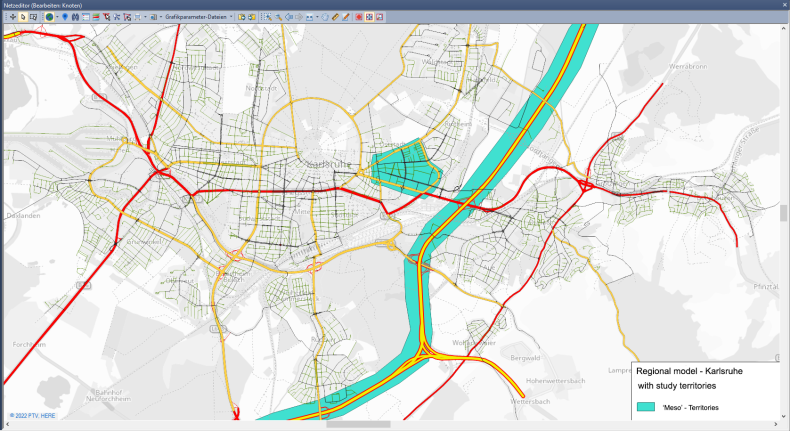Regional travel demand models often serve as a basis for project studies in selected parts of the model area. Depending on the size of the study area to be investigated, either sub-networks are created and used for the study, i.e. detached from the original model, or the regional model is adapted to the requirements of the project. If time-dynamic phenomena like the emergence and development of congestion are to be included in the assessment in addition to the shift of volumes, a dynamic assignment procedure is required. However, adding the required level of detail to the models can often require a significant effort.
The macro-meso hybrid simulation addresses the shortcomings of the mentioned approaches by combining areas modeled in varying detail in one assignment. On the one hand, this enables a large-scale view, and on the other hand, the modeling effort and runtime are drastically reduced compared to a purely mesoscopic approach. Thus, the macro-meso hybrid simulation simplifies access to the application of SBA.
In principle, the use cases are similar to those for simulation-based assignment without a hybrid approach, but detailed modeling is required only for the narrower study area. Examples of such studies include:
- The introduction of dedicated lanes, e.g. for vehicles with a higher occupancy rate or autonomous vehicles, or environmental lanes.
- Construction sites with temporary restrictions for traffic
The macro-meso hybrid simulation allows not only a detailed view of impacts in the study area itself but also estimates of changes in route choice behavior in the broader vicinity of the study area. The macro-meso hybrid simulation is implemented as an extension of simulation-based assignment (SBA). The distinction between the study area, i.e. the part of the network on which mesoscopic simulations are performed, and the other model area is made using a link attribute.

Illustration 147: Macro-meso simulation
The main difference between the hybrid approach and a purely mesoscopic assignment is the determination of the travel time functions for the macroscopically modeled part. While at mesoscopically simulated network objects the travel times change according to the measurements during the simulation, the travel times in the macroscopic part of the network are constant and depend only on the volume in the assignment time period.
|
|
|
Illustration 148: Example of travel time functions for one network object each in the mesoscopically (left) and macroscopically (right) simulated part of the network
The travel time functions form the basis for determining the impedances and thus also for the route search and volume balancing.
The determination of the travel time function in the macroscopically modeled part of the network results from the input data typical for a static assignment, i.e. for this part of the network capacities, VD functions, and base volume have to be defined reasonably for the assignment time period.
Particularities
This section lists some particularities of the macro-meso hybrid simulation.
The following applies to the macro area:
- There are no conflicts at nodes.
- There is no spillback.
- Detailed modeling of node geometry and control is not necessary.
- Node impedances can be represented by VD functions. If the node impedance calculation ICA is chosen as the method, it should be noted that hourly values are interpreted as volumes and that results where the volume exceeds the capacity calculated by ICA may be incorrect.
The path of a vehicle can be exclusively in the macro or meso area or alternate between the two. For the transitions from the macro to the meso area and also from the meso to the macro area, connector edges are generated internally. If vehicles cannot enter a meso area due to congestion, vertical congestion occurs on these internal connector edges, i.e., no spillback that extends into the macro area.
The following is an example of a node of the roundabout control type at the transition between the macro and meso areas. The green links (Illustration 149) belong to the meso area, the other two links are in the macro area.
|
|
|
Illustration 149: Node of the control type roundabout in the transition between macro and meso area
On the right side of Illustration 149, the node-edge graph (simulation graph) is shown, i.e. here applies:
- For nodes at the transition, the geometry is generated, i.e. in the case of the roundabout, it is expanded according to the inputs.
- For the links in the meso area, the edges of the simulation graph (green) are generated as usual.
- Macro-meso or meso-macro connector edges are created internally for links in the macro area.
This also implies, among other things, that vehicles leaving the macro area via an internal macro-meso connector edge and then returning to the macro area via an internal meso-macro connector edge, travel along at least one turn edge of the simulation graph. Thus, they are visible to other vehicles that remain within the meso area, for example, and have an impact on the capacity at the node.
Input and output attributes
At network objects in the meso area, all result attributes are generated as in a purely mesoscopic application (SBA without hybrid simulation). In the macro area, output attributes are generated as for static assignments (including volumes, travel times, and impedances). In addition, the propagation of vehicles through the network creates time-dependent network volumes in the macro area as well.
The quality data of the assignment is stored in the PrT simulation-based assignment quality data list and always refers to the entire network. Six attributes are generated exclusively from the mesoscopic simulation:
- Simulation number of vehicles
- Simulation number of remaining vehicles on connectors
- Simulation number of vehicles remaining in network
- Simulation vehicle kilometers traveled PrT
- Simulation vehicle hours traveled t0
- Simulation vehicle hours traveled tCur
There is another attribute, Simulation number of vehicles remaining in macro simulation area, which shows the number of remaining vehicles in the macro area that still passes through at least one meso area.
Subsequent evaluations
The macro-meso hybrid simulation does not impose any restrictions on subsequent evaluations (e.g., dynamic skim or flow bundle calculations with time constraints) or the applicability of dynamic procedures (dynamic matrix estimation, subnetwork generation with demand time series, Vissim export with dynamic volumes).





